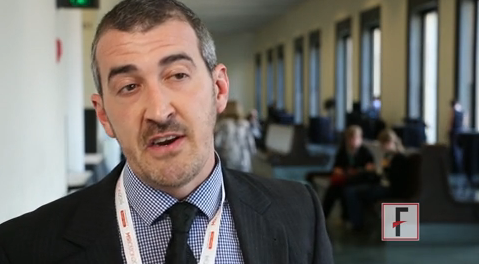User login
BOSTON – When trying to predict how quickly high-risk patients with clinically isolated syndrome may convert to clinically definite multiple sclerosis, consider age at onset, disease-modifying drug use, MRI lesion load, and the presence of cerebrospinal fluid oligoclonal bands, according to Dr. Tim Spelman.
Dr. Spelman and his colleagues analyzed the MSBase Incident Study subset of high-risk patients from the MSBase Registry to conduct the largest longitudinal, prospective study of patients followed from onset of clinically isolated syndrome (CIS).
Older age at CIS was protective for conversion to clinically definite MS. The basis for how older age at onset lowers risk “is still somewhat of a mystery because the variable itself doesn’t correlate with other known predictors like oligoclonal bands, MRI, EDSS [Expanded Disease Status Scale],” Dr. Spelman said in a video interview at the joint meeting of the European and Americas Committees for Treatment and Research in Multiple Sclerosis. Spinal lesions on MRI also tended to capture about the same amount of risk at baseline as did oligoclonal bands, he noted. Treatment with disease-modifying drugs (DMDs) extended the median time to conversion from 11 months without treatment to 4 years with treatment, regardless of the DMD type or duration.
With all of these predictors assembled, the next phase is to develop a risk calculator, said Dr. Spelman of the Melbourne Brain Centre at the Royal Melbourne Hospital in Parkville, Australia.
[email protected]
The video associated with this article is no longer available on this site. Please view all of our videos on the MDedge YouTube channel
BOSTON – When trying to predict how quickly high-risk patients with clinically isolated syndrome may convert to clinically definite multiple sclerosis, consider age at onset, disease-modifying drug use, MRI lesion load, and the presence of cerebrospinal fluid oligoclonal bands, according to Dr. Tim Spelman.
Dr. Spelman and his colleagues analyzed the MSBase Incident Study subset of high-risk patients from the MSBase Registry to conduct the largest longitudinal, prospective study of patients followed from onset of clinically isolated syndrome (CIS).
Older age at CIS was protective for conversion to clinically definite MS. The basis for how older age at onset lowers risk “is still somewhat of a mystery because the variable itself doesn’t correlate with other known predictors like oligoclonal bands, MRI, EDSS [Expanded Disease Status Scale],” Dr. Spelman said in a video interview at the joint meeting of the European and Americas Committees for Treatment and Research in Multiple Sclerosis. Spinal lesions on MRI also tended to capture about the same amount of risk at baseline as did oligoclonal bands, he noted. Treatment with disease-modifying drugs (DMDs) extended the median time to conversion from 11 months without treatment to 4 years with treatment, regardless of the DMD type or duration.
With all of these predictors assembled, the next phase is to develop a risk calculator, said Dr. Spelman of the Melbourne Brain Centre at the Royal Melbourne Hospital in Parkville, Australia.
[email protected]
The video associated with this article is no longer available on this site. Please view all of our videos on the MDedge YouTube channel
BOSTON – When trying to predict how quickly high-risk patients with clinically isolated syndrome may convert to clinically definite multiple sclerosis, consider age at onset, disease-modifying drug use, MRI lesion load, and the presence of cerebrospinal fluid oligoclonal bands, according to Dr. Tim Spelman.
Dr. Spelman and his colleagues analyzed the MSBase Incident Study subset of high-risk patients from the MSBase Registry to conduct the largest longitudinal, prospective study of patients followed from onset of clinically isolated syndrome (CIS).
Older age at CIS was protective for conversion to clinically definite MS. The basis for how older age at onset lowers risk “is still somewhat of a mystery because the variable itself doesn’t correlate with other known predictors like oligoclonal bands, MRI, EDSS [Expanded Disease Status Scale],” Dr. Spelman said in a video interview at the joint meeting of the European and Americas Committees for Treatment and Research in Multiple Sclerosis. Spinal lesions on MRI also tended to capture about the same amount of risk at baseline as did oligoclonal bands, he noted. Treatment with disease-modifying drugs (DMDs) extended the median time to conversion from 11 months without treatment to 4 years with treatment, regardless of the DMD type or duration.
With all of these predictors assembled, the next phase is to develop a risk calculator, said Dr. Spelman of the Melbourne Brain Centre at the Royal Melbourne Hospital in Parkville, Australia.
[email protected]
The video associated with this article is no longer available on this site. Please view all of our videos on the MDedge YouTube channel
AT MSBOSTON 2014
